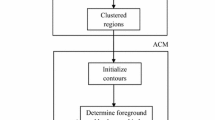Abstract
Automatic segmentation and tracking systems can be useful tools for biologists to monitor and understand the proliferation and the differentiation of neural stem cells. This paper applied the self-organizing map-based multi-thresholding on the neural stem cells images. Using local variance as the local spatial feature and quadtree decomposition as the sub-sampling method, inner-cell regions, cell borders and background can be roughly classified. Based on these results, proper foreground and background seeds were constructed for the seeded watershed segmentation and every single cell in a cell cluster can be segmented correctly. The results were also compared to the seeded watershed segmentation based on regional maxima method.






Similar content being viewed by others
References
Althoff K, Degerman J, Gustavsson T (2005) Combined segmentation and tracking of neural stem-cells. Lect Notes Comput Sci 3540:282–291
Althoff K, Degerman J, Gustavsson T (2005) Tracking neural stem cells in time-lapse microscopy image sequences. Proc SPIE 5747:1883–1891. doi:10.1117/12.594767
Bengtsson E (2003) Computerized cell image analysis: past, present, and future. Lect Notes Comput Sci 2749:395–407
Campos LS (2004) Neurospheres: insights into neural stem cell biology. J Neurosci Res 78:761–769. doi:10.1002/jnr.20333
Gage HF (2000) Mammalian neural stem cells. Science 287:1433–1438. doi:10.1126/science.287.5457.1433
Haykin S (1999) Neural networks: a comprehensive foundation, 2nd edn. Prentice-Hall, New Jersey
Kachouie NN, Fieguth P (2005) A narrow-band level-set method with dynamic velocity for neural stem cell cluster segmentation. Lect Notes Comput Sci 3656:1006–1013
Laywell ED, Kukekov VG, Suslov O (2002) Production and analysis of neurospheres from acutely dissociated and postmortem CNS specimens. In: Zigova T (ed) Methods in molecular biology, vol. 198: Neural stem cells: methods and protocols. Humana Press, Totowa, pp 15–28
Lindvall O, Kokaia Z (2006) Stem cells for the treatment of neurological disorders. Nature 441:1094–1096. doi:10.1038/nature04960
Lindvall O, Kokaia Z, Martinez-Serrano A (2004) Stem cell therapy for human neurodegenerative disorders—how to make it work. Nat Med 10:S42–S50
McKay R (1997) Stem cell in the central nervous system. Science 276:66–71. doi:10.1126/science.276.5309.66
Papamarkos N (2003) A neuro-fuzzy technique for document binarisation. Neural Comput Appl 12:190–199. doi:10.1007/s00521-003-0382-z
Papamarkos N, Atsalakis A (2000) Gray-level reduction using local spatial features. Comput Vis Image Underst 78:336–350. doi:10.1006/cviu.2000.0838
Papamarkos N, Strouthopoulos C, Andreadis I (2000) Multithresholding of color and gray-level images through a neural network technique. Image Vis Comput 18:213–222. doi:10.1016/S0262-8856(99)00015-3
Pinidiyaarachchi A, Wahlby C (2005) Seeded watersheds for combined segmentation and tracking of cells. Lect Notes Comput Sci 3617:336–343
Reddi SS, Rudin SF, Keshavan HR (1984) An optimal multiple threshold scheme for image segmentation. IEEE Trans Syst Man Cybern 14:661–665
Shah-Hosseini H, Safabakhsh R (2002) Automatic multilevel thresholding for image segmentation by the growing time adaptive self-organizing map. IEEE Trans Pattern Anal Mach Intell 24:1388–1393. doi:10.1109/TPAMI.2002.1039209
Shusterman E, Feder M (1994) Image compression via improved quadtree decomposition algorithms. IEEE Trans Image Process 3:207–215. doi:10.1109/83.277901
Tang C, Bengtsson E (2005) Segmentation track neural stem cell. Lect Notes Comput Sci 3645:851–859
Vincent L (1993) Morphological gray scale reconstruction in image analysis: applications and efficient algorithms. IEEE Trans Image Process 2:176–201. doi:10.1109/83.217222
Vincent L, Soille P (1991) Watersheds in digital spaces: an efficient algorithm based on immersion simulations. IEEE Trans Pattern Anal Mach Intell 13:583–598. doi:10.1109/34.87344
Wu K, Gauthier D, Levine MD (1995) Live cell image segmentation. IEEE Trans Biomed Eng 42:1–12. doi:10.1109/10.362924
Acknowledgment
This work was supported by the Shenzhen Key Laboratory Program of Health Science and Technology.
Author information
Authors and Affiliations
Corresponding author
Rights and permissions
About this article
Cite this article
Qian, X., Peng, C., Wang, X. et al. Self-organizing map-based multi-thresholding on neural stem cells images. Med Biol Eng Comput 47, 801–808 (2009). https://doi.org/10.1007/s11517-009-0489-1
Received:
Accepted:
Published:
Issue Date:
DOI: https://doi.org/10.1007/s11517-009-0489-1




